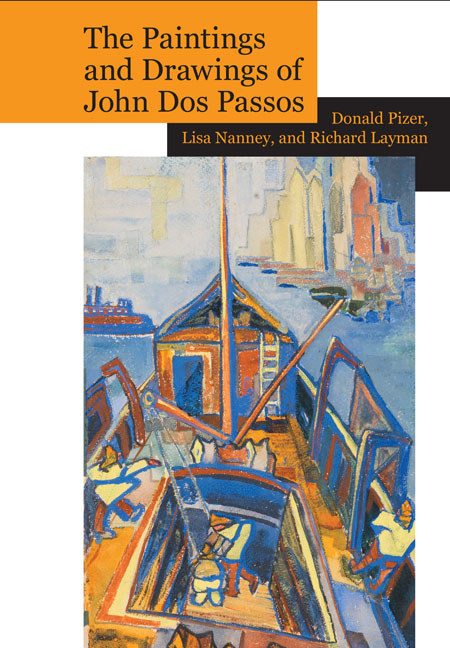Book contents
- Frontmatter
- Contents
- Preface
- Acknowledgments
- The Paintings and Drawings of John Dos Passos: A Collection and Study
- Introduction
- Paintings and Drawings Included in this Volume: A Descriptive List
- Preface to Section 1: Early Work 1918–20
- Preface to Section 2: The Middle East and Morocco 1921–22, 1926
- Preface to Section 3: Paris 1921–25
- Preface to Section 4: New York 1920–24
- Preface to Section 5: New York: Nudes 1920–23
- Preface to Section 6: Theater Designs 1925–28
- Preface to Section 7: Mexico 1926–32
- Preface to Section 8: Later Work 1930–70
- Preface to Section 9: Portraits
- Preface to Section 10: Sea Fronts and Harbors
- Preface to Section 11: Still Lifes
- Preface to Section 12: Studies in Motion
- Preface to Section 13: Abstractions and Other Experimental Modes
- Words and Images: The Visual Art of John Dos Passos
- The Artwork of John Dos Passos
- Notes
- Works Cited
- Index
- Plate section
Introduction
from The Paintings and Drawings of John Dos Passos: A Collection and Study
- Frontmatter
- Contents
- Preface
- Acknowledgments
- The Paintings and Drawings of John Dos Passos: A Collection and Study
- Introduction
- Paintings and Drawings Included in this Volume: A Descriptive List
- Preface to Section 1: Early Work 1918–20
- Preface to Section 2: The Middle East and Morocco 1921–22, 1926
- Preface to Section 3: Paris 1921–25
- Preface to Section 4: New York 1920–24
- Preface to Section 5: New York: Nudes 1920–23
- Preface to Section 6: Theater Designs 1925–28
- Preface to Section 7: Mexico 1926–32
- Preface to Section 8: Later Work 1930–70
- Preface to Section 9: Portraits
- Preface to Section 10: Sea Fronts and Harbors
- Preface to Section 11: Still Lifes
- Preface to Section 12: Studies in Motion
- Preface to Section 13: Abstractions and Other Experimental Modes
- Words and Images: The Visual Art of John Dos Passos
- The Artwork of John Dos Passos
- Notes
- Works Cited
- Index
- Plate section
Summary
As a young man, Dos Passos enjoyed and had a talent for sketching. After graduating from Harvard in 1916, he attempted to join the Belgian Relief Commission, but when rejected as too young, went instead to Madrid to study architecture, and it was there that he had his first lessons in drawing and also made architectural sketches. At his father's death in early 1917, Dos Passos returned to New York and enlisted in the volunteer ambulance corps. Over the next two years, while both in the corps and then in the U.S. Army, he spent considerable time in Paris, where he sporadically participated in drawing classes. His first extensive artistic efforts occurred during early 1918, while serving in the ambulance corps in Italy, when he frequently made pencil sketches and occasionally painted watercolors in his notebooks. His initial efforts to paint in watercolors in a larger format appear to date from the summer of 1919, when he was living in Spain while writing his novel Three Soldiers. Dos Passos had become close friends with a fellow corps member, the writer John Howard Lawson. When Lawson's wife and sister, Adelaide Lawson, made a visit to Barcelona and then Majorca in late March 1920, Dos Passos joined them and used the occasion to paint a number of watercolors of local scenes. Adelaide, who was seven years older than Dos Passos and who was already an accomplished artist, occasionally painted in watercolor, and she perhaps at this time also further instructed Dos Passos in the medium. Dos Passos was seldom to use any other. He was highly peripatetic throughout his life, and unlike oils and canvas, the paints and pads for water coloring could easily be carried in a suitcase while traveling.
The early 1920s can be considered the watershed years in Dos Passos's career. He was not only working toward the radical fictional form of Manhattan Transfer —the novel which established his centrality in 1920s avant-garde fiction—but also vigorously seeking out a style and subject matter as a painter. On his return to New York in mid-1920, he joined forces (so to speak) with Adelaide Lawson, who lived and studied in the city, and entered fully the New York art scene.
- Type
- Chapter
- Information
- Publisher: Liverpool University PressPrint publication year: 2016



